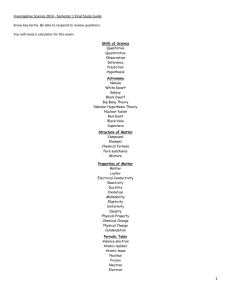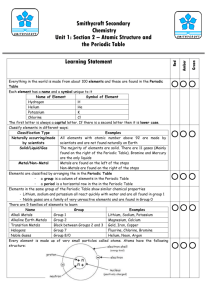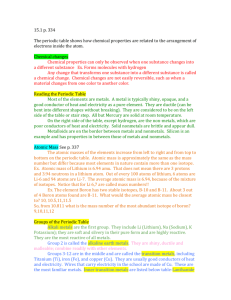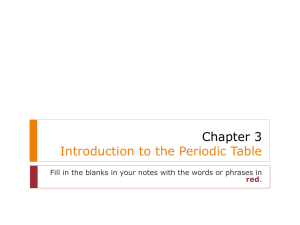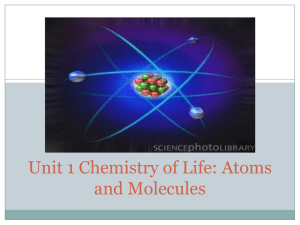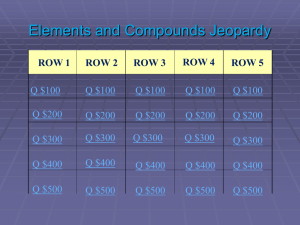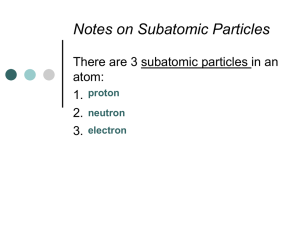Cornell Notes Periodic Table of the Elements
advertisement
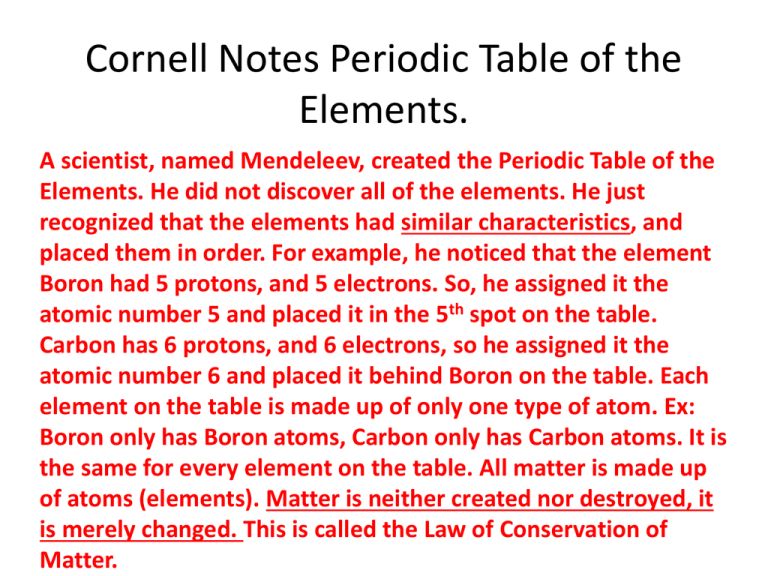
Cornell Notes Periodic Table of the Elements. A scientist, named Mendeleev, created the Periodic Table of the Elements. He did not discover all of the elements. He just recognized that the elements had similar characteristics, and placed them in order. For example, he noticed that the element Boron had 5 protons, and 5 electrons. So, he assigned it the atomic number 5 and placed it in the 5th spot on the table. Carbon has 6 protons, and 6 electrons, so he assigned it the atomic number 6 and placed it behind Boron on the table. Each element on the table is made up of only one type of atom. Ex: Boron only has Boron atoms, Carbon only has Carbon atoms. It is the same for every element on the table. All matter is made up of atoms (elements). Matter is neither created nor destroyed, it is merely changed. This is called the Law of Conservation of Matter. How to read key box of Periodic Table. • The top number in each box (in your book) tells you the atomic number (same as protons, electrons). • Then you will see the element symbol (first letter of each symbol is capitalized, the rest are not) • Then you will see the name of the Element • Then you will see the atomic mass number. Groups/Columns on the Periodic Table • Elements (atoms) in the same group/column have the same number of electrons in their Outermost enery level. Groups/Columns on the Periodic Table Group numbers are found at the top of each column. • Group/Column 1: Called Alkali Metals-highly reactive. This means that they bond easily because they only have 1 electron. They are all metals and conduct heat and electricity easily. They are the softest metals. Group/Column • Group 2 are the alkaline metals. Alkaline metals are also good conductors of heat/electricity. They also bond easily with other elements because they only have 2 electrons. • Groups 3-12 are called transition metals. They conduct electricity and heat. • Groups 13, 14, 15 are called other metals. They are all solids. • Groups 14-16 are the non-metals. They are very brittle and don’t conduct electricity or heat well. Group/Column Halogens are five non-metal elements found in group 17. They bond easily because their outer shells are missing 1 electron. Group 18 is the noble gases. They don’t bond because their outer shells are full. Periods/Rows on the Periodic Table • The elements in each period/row are placed according to their atomic number, or number of protons and electrons. As you move across the period/row, the atomic number, or number of protons and electrons, increases by one. All of the elements in one period/row have similar chemical characteristics. Image of Periods/rows on Periodic Table. • Period/row numbers are located to the left of the row on the table. Other facts about Periodic Table • All atoms in the same group/column have similar chemical properties. • All atoms in the same period/row have similar chemical properties. • Some elements are solids, some are liquids, some are gases. • All elements are arranged on the PT according to their similar chemical properties/characteristics. Match the element on the left that has the most similar characteristics the element on the right: • • • • • • • Carbon(C) Calcium(Ca) Nickel(Ni) Lanthanum(La) Helium(He) Chromium(Cr) Flourine(F) Actinum(Ac) Tungsten(W) Iodine(I) Krypton(Kr) Tin(Sn) Barium(Ba) Platinum(Pt)
